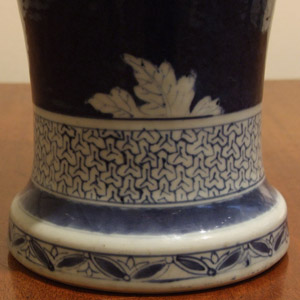
KANGXI 1622 – 1722 Powder Blue Porcelain
A Large Rare Kangxi Blue and White Powder-Blue Ground Vase c.1690-1710. Decorated in the Japanese Taste.
SOLD
- Condition
- Good, the rim with numerous small chips and fritting. Some glaze scratches to the body.
- Size
- Height : 58 cm (23 inches).
- Provenance
- N/A
- Stock number
- 21970
Information
The colour is much better than in these photographs.
Powder-Blue Decoration :
This type of decoration is associated with the Kangxi period but its origins can be traced to the end of the Ming Dynasty, during the reigns of Tianqi and Chongzhen. Indeed these pieces are a revival of an early Ming technique that seems to have been abandoned or lost at about the time of Xuande. The late Ming examples comprise a group of dishes made at the Jingdezhen kilns during the second quarter of the 17th century. They use an uneven blue ground of a mottled appearance (see `Sold Items` 19206 and 17133), referred to as `Fukizumi` in Japanese they have the characteristics of what we now call powder blue. It was during the Kangxi (1662-1722) that the technique became refined and combined with gilding, Famille Verte or other over-glaze colours. Powder-blue glazes are somewhat different from other Qing blue glazes in that the cobalt was not mixed with the glaze. Instead, it was blown dry onto the biscuit body of the porcelain by using a piece of gauze stretches over the end of a bamboo tube. The result is a somewhat frothy soft effect. Paper or wax resist were used to reserve areas from the blue that could then be decorated after glazing.




